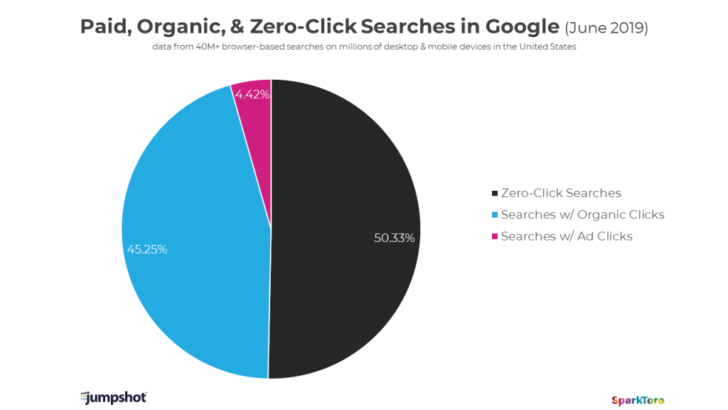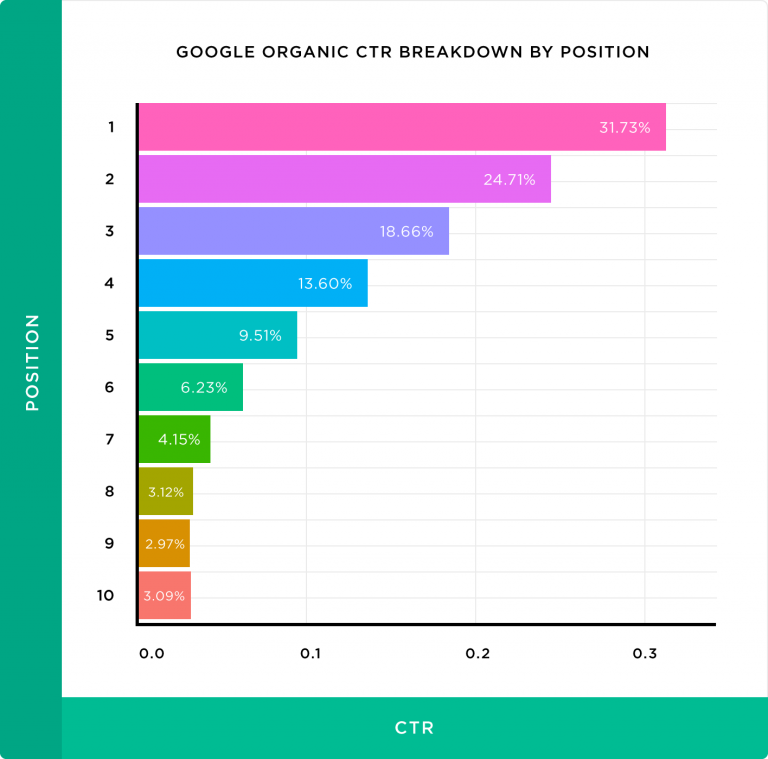30-second summary:
- Search engine ranking pages and algorithms are evolving quickly and you should keep pace with them to succeed.
- Did you know, 51% of all searches end without a click?
- Gone are the days when there are only organic text-based results on the page.
- Today, there are paid listings, zero-click searches, images, videos, maps, featured snippets, people also asked for boxes, and even podcasts that result in dismal click-through rates (CTRs).
- Branex’s digital marketing strategist, Irfan Ak has created a top 10 list that can boost your CTR in Google SERPs.
If you closely look at the first page of Google for any competitive keyword, you will find tons of elements on it. Gone are the days when there are only organic text-based results on the page. Today, there are images, videos, maps, featured snippets, people also asked for boxes, and even podcasts. Then there are paid listings which are visible on top of organic listings. SEO trends are changing quickly and it is impacting search engine results pages (SERPs). All this translates into declining organic reach, dismal click-through rate (CTR), and the rise of zero-click searches.
In fact, 51% of all searches end without a click. With search engines trying their best to fulfill user needs on search pages itself, fewer users will scroll down and click through your listing as they get the desired answer on the search page.
In this article, you will learn about ten effective ways to boost click-through rate (CTR) using SERPs.

Source: SparkToro
1. Optimize for featured snippets
The coveted number one spot is no longer the target for digital marketers and digital marketing agencies. The focus has shifted to Position Zero. According to Ahrefs study, 12.3% of search queries have featured snippets. Search engines like Google pull data from the top 10 results to show as a featured snippet. If your blog or website is ranking on the first page of Google, you have an opportunity to grab the featured snippet and boost your visibility.
To do so, you need to understand the purpose of featured snippets. The main reason why search engines show featured snippets is that they want to provide a direct answer to a search query and if your listing does that, you have a bright chance of getting featured on a much sought-after position zero.

Source: Ahrefs
Secondly, featured snippets are displayed for long-tail keywords or questions-based queries. The focus is usually on offering short and precise answers to the user query and if your listing can do that while optimizing for long-tail keywords, it can rank on featured snippets.
2. Improve your rankings
According to a study conducted by Backlnko which analyzed 5 million Google search results, moving one spot up can increase your click-through rate by almost 30.8%. Even though, this might vary depending on your current position and the position you have moved to. The same study also found that jumping from 10th position to 7th position did not have the same impact as moving from 6th position to 5th position or 2nd position to 1st position might have on your click-through rate. Instead of striving for ranking on the first page of Google, you should focus on ranking in the top three positions as 75.1% of all clicks go to the top three spots.

Source: Backlinko
3. Write captivating headlines
David Ogilvy, the “Father of Advertising” and Founder of Ogilvy & Mather, once said,
“On the average, five times as many people read the headline as read the body copy. When you have written your headline, you have spent eighty cents out of your dollar.”
What is the first thing that users will read when they look at your listing? It is the headline. It can literally make it or break it for you. That is why it is important to write attention-grabbing headlines. Add an emotional element to your headline as research has shown that including positive or negative sentiments to your headlines can increase its click-through rate by 7%. Backlinko’s study I referenced above also found that titles that contain 15-40 characters have the highest organic click-through rate.
4. Meta description and URL
Have you ever seen a search result closely? What does it contain? A search engine listing usually comprises of three things
- Title
- URL
- Meta Description
After optimizing your title, you should focus on optimizing your URL and meta description for click-through rate. Add your keyword in the URL as it will increase your clickthrough rate by 45% as compared to URLs that don’t contain the keyword.
Just like the title and URL, add your keyword in the meta description as well. Write a meta description in active voice and try to make it as actionable as possible. Don’t forget to add a call to action to persuade users to click on your listings. Make sure all the pages on your website have a meta description because pages that contain the meta description generate 5.8% more clicks than pages without meta description.
5. Add a schema markup
Search engines use a spider to crawl web pages and create an index of all those pages. The easier it is for search engines to crawl your website, the faster they will crawl your website and more likely your website to get indexed and ranked. By adding schema markup to your website, you can make it easy for search engines to understand what your website is all about and how different pages on your website covers.
There are different types of schema markups and implementing the right kind on your website can do wonders. For example, a review schema markup allows search engines to display ratings in your organic results. If your rating is good, it can increase your credibility, build trust, and help you attract new customers while increasing your click-through rate.
6. Optimize for Google My Business
Do you have a Google My Business page? If your answer is no, then you are missing out. Get your business featured on Google My Business and enter all the business details. Whether it is location-based searches, branded searches, or business-related or service-related searches, Google My Business results tend to show up.
Another advantage of using Google My Business is that it allows you to collect reviews and ratings from customers as well as allows your business to answer user questions. Both can help you build trust and win new customers. The more positive reviews your business has or the higher the rating, the better. It also offers some useful features to customers such as sharing business information with others or contacting the business directly.
7. Run well-targeted PPC ads
One of the best ways to overcome declining organic reach is to invest in PPC ads. Yes, they might be expensive in certain industries and might not work that well in other industries but if you are looking for quick results, PPC ads are your best bet, provided your PPC targeting strategy is on the money. Run PPC ads on branded keywords and prevent others from occupying your ad space.
When you run PPC ads, it attracts targeted traffic that is more likely to convert into paying customers. This means that it not only increases your click-through rate but also increases your conversion rates too. The key to success with PPC ads is to choose the right ad type according to your industry.
8. Optimize images and videos for SEO
As mentioned before, SERPs are no longer limited to showing organic results anymore. They also show images, videos, and featured snippets to name just a few. What’s even more interesting is the fact that SERPs showing images and videos are slowly but surely increasing in number. This means that you can optimize your images and videos to increase your chances of ranking on these SERPs.
Here are some of the ways you can use to optimize images for SEO.
- Use targeted keywords in image and video title, description, and alternate text
- Place the image and video in a section of the page or in content where it best matches the keyword intent
- Compress large size images and videos
- Add a caption to images
- Use common image sizes and optimal image formats
9. Give an irresistible limited time offer
Create a sense of urgency and use tactics such as countdown timer or mention the number of items remaining. When a user sees these things on your page, they are rushed into taking the desired action. Give a limited time offer that your target audience cannot resist, and you will see your clickthrough rate shoot through the roof. Don’t forget to add a call to action that tells users which action they should take next.
10. Optimize social media channel to show up in knowledge panels
Last but certainly not least is to optimize social media pages for knowledge panels. Search engines display these knowledge panels in order to present all your business information in a concise way. As a business, you can use this as an opportunity to connect your social media accounts and let users contact you directly from search engine results pages. For this process to work, all your social media accounts should pass the verification by Google. You can also use schema markup to highlight your social media accounts.
How do you boost your click-through rate using search engine result pages? Let us know in the comments section below.
Irfan Ak is an experienced digital marketing strategist, growth hacker, digital transformation expert at Branex. He can be found on Twitter @irrfanAK.







